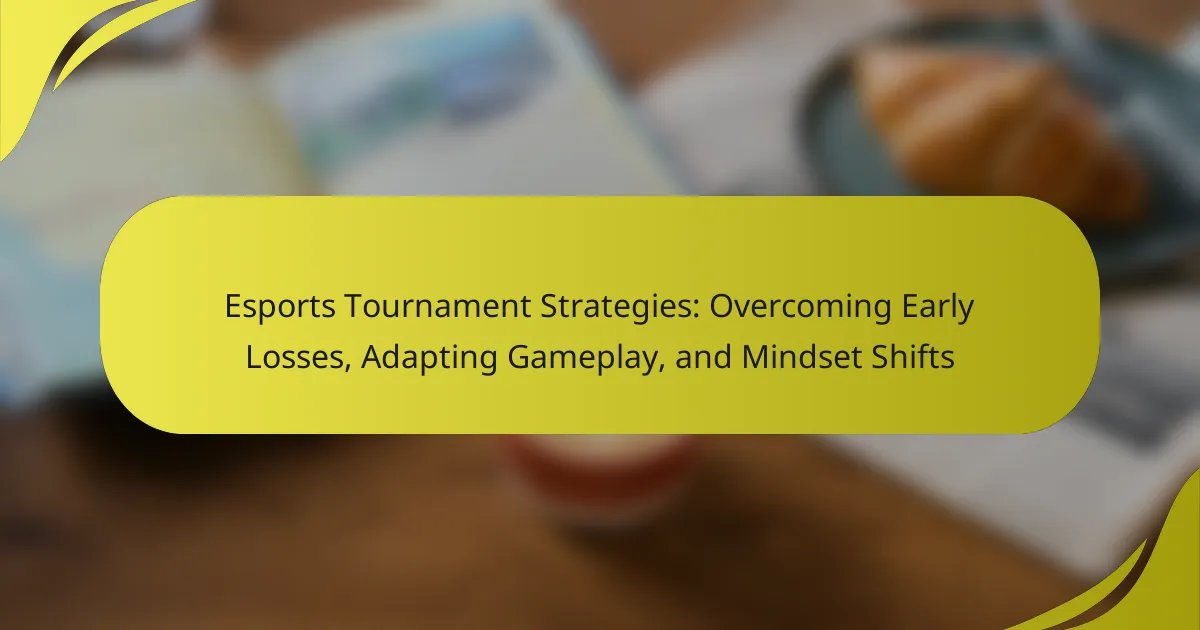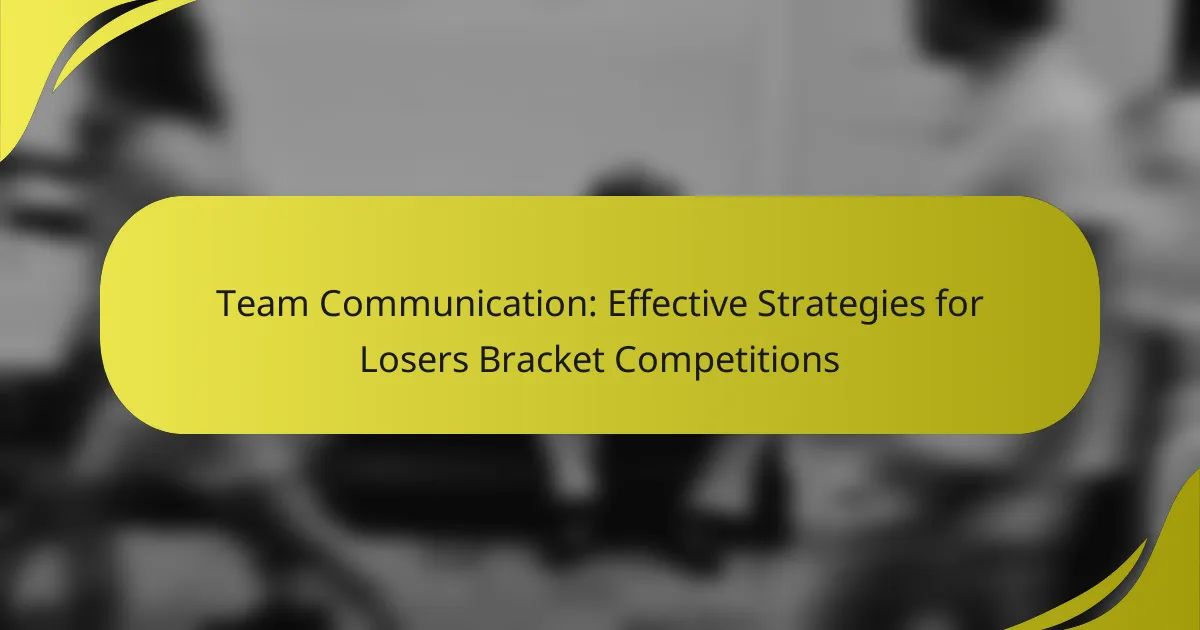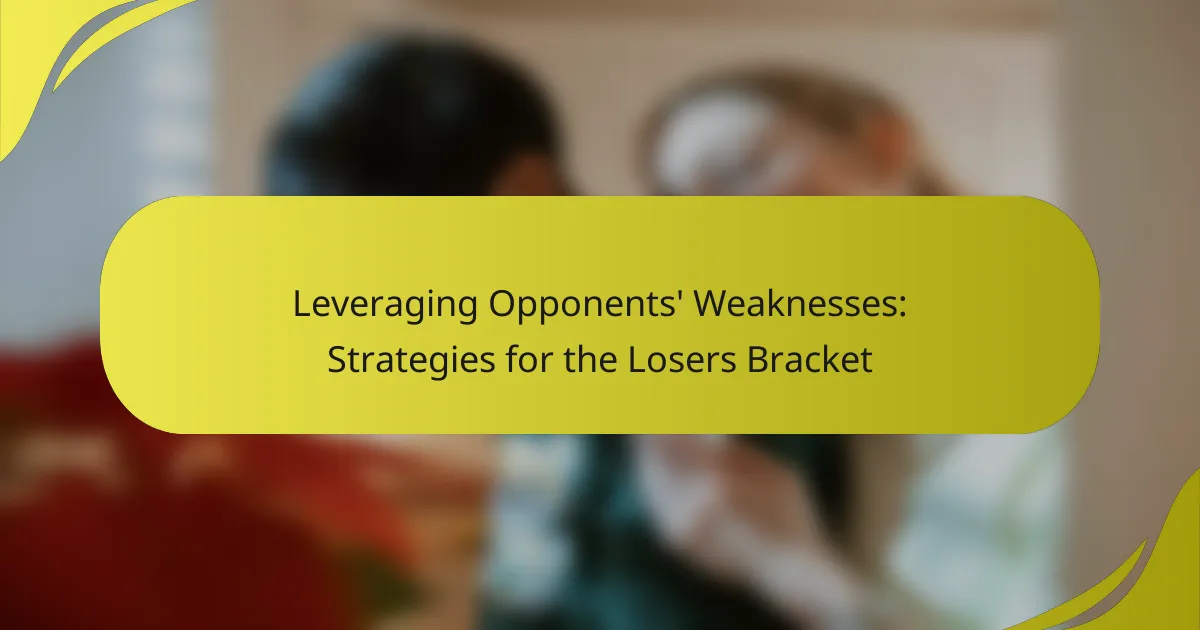In the fast-paced world of esports tournaments, overcoming early losses is crucial for success. Teams can achieve this by implementing strategic adjustments, improving communication, and cultivating a resilient mindset. By adapting their gameplay and embracing a positive outlook, players can turn setbacks into opportunities for growth and improvement.
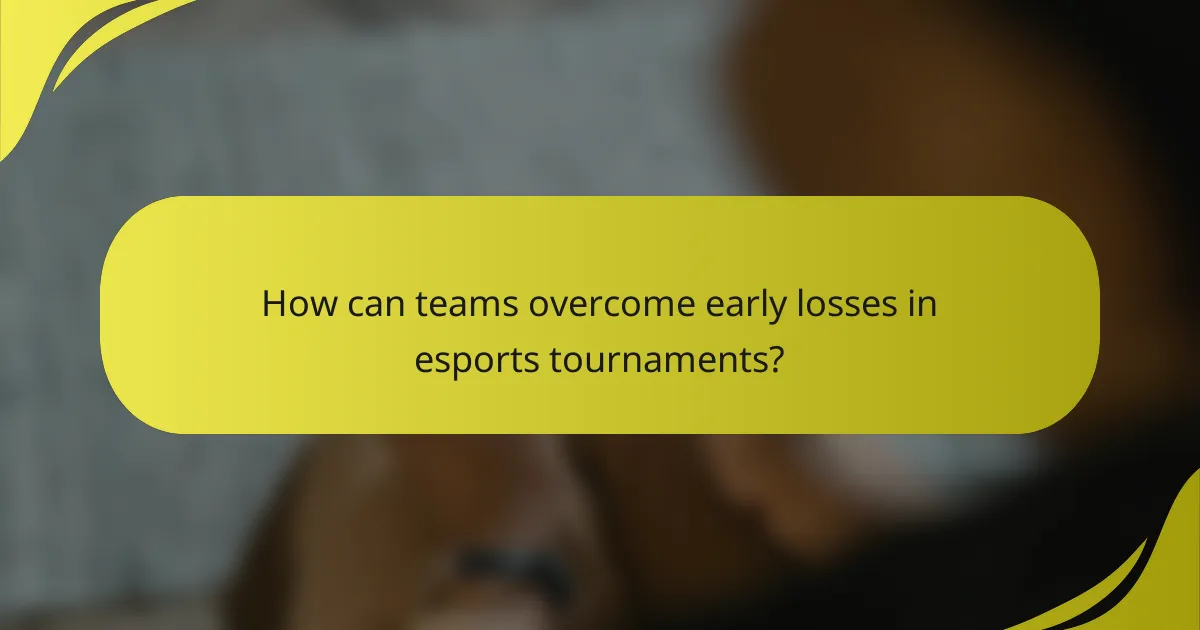
How can teams overcome early losses in esports tournaments?
Teams can overcome early losses in esports tournaments by focusing on strategic adjustments, enhancing communication, and fostering a resilient mindset. Recognizing the need for change and implementing effective strategies can turn the tide in subsequent matches.
Analyzing opponent strategies
Understanding the strategies employed by opponents is crucial after an early loss. Teams should review match footage to identify patterns, strengths, and weaknesses in their opponents’ gameplay. This analysis allows for targeted adjustments in future encounters.
Consider creating a checklist of key strategies used by opponents, such as specific champion picks or tactical formations. This can help in formulating counter-strategies that exploit their vulnerabilities.
Adjusting team composition
Modifying team composition can significantly impact performance after a setback. Teams should evaluate whether their current lineup effectively counters the opponent’s strengths or if alternative champions or roles may provide a better chance of success.
For instance, if an early loss was due to a lack of crowd control, consider incorporating champions that offer more utility. Regularly revisiting team composition based on opponents can provide a strategic edge.
Implementing psychological resilience
Building psychological resilience is essential for teams facing early losses. Players should focus on maintaining a positive mindset and learning from mistakes rather than dwelling on failures. Techniques such as visualization and mindfulness can help improve mental fortitude.
Encourage team members to share their thoughts and feelings after a loss, fostering an environment where players support one another. This can help mitigate the negative impact of early setbacks on overall team morale.
Utilizing in-game communication
Effective in-game communication can make a significant difference in overcoming early losses. Teams should establish clear communication protocols to ensure that all players are on the same page regarding strategies and objectives.
Consider implementing a system of callouts for specific plays or danger signals. Regularly practicing communication during scrims can enhance coordination and responsiveness during high-pressure situations.
Revising game plans
After an early loss, revising game plans is critical for future success. Teams should assess what went wrong and develop a revised strategy that addresses identified weaknesses. This may involve altering objectives, pacing, or engagement tactics.
Utilize a structured approach to game plan revision, such as SWOT analysis (Strengths, Weaknesses, Opportunities, Threats), to ensure a comprehensive evaluation. This can help teams adapt more effectively to the evolving dynamics of the tournament.
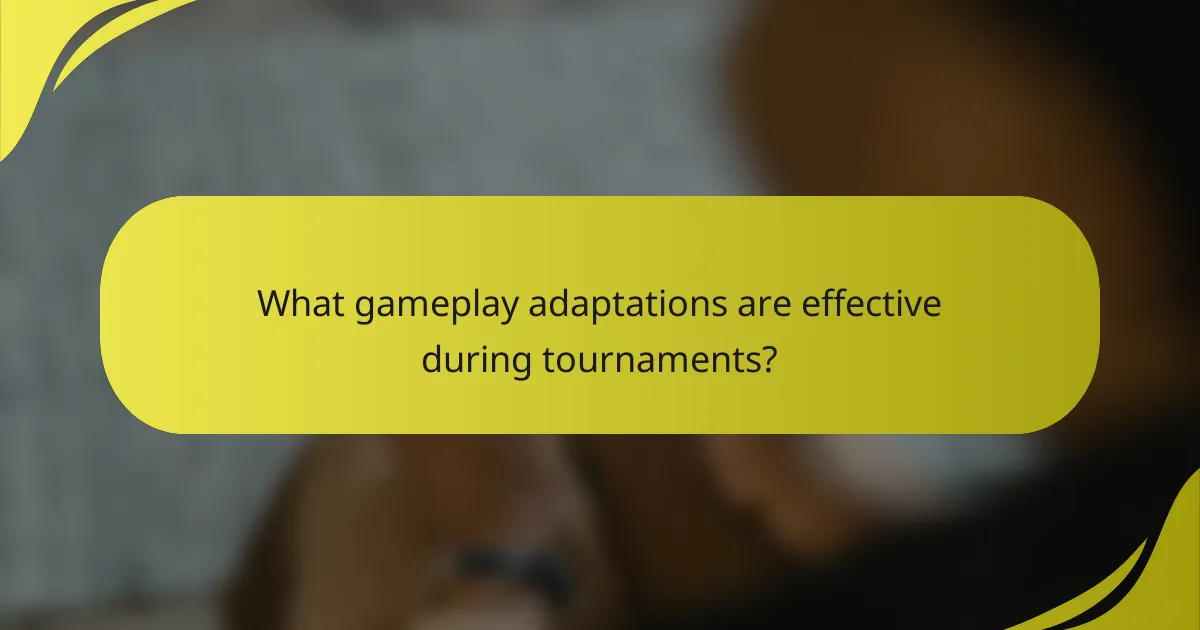
What gameplay adaptations are effective during tournaments?
Effective gameplay adaptations during tournaments involve quickly adjusting strategies and tactics based on the evolving dynamics of the match. Teams must be prepared to shift their approach to counter opponents and leverage their strengths, especially after early setbacks.
Switching playstyles mid-game
Switching playstyles mid-game can disrupt opponents’ strategies and regain momentum. For instance, if a team starts with an aggressive approach but faces early losses, transitioning to a more defensive style can help mitigate risks and create opportunities for counterattacks.
Consider the strengths of your roster when making this switch. If players excel in defensive roles, emphasizing this can turn the tide. However, ensure that all team members are on board with the change to maintain cohesion.
Incorporating counter-strategies
Incorporating counter-strategies is crucial for overcoming early losses. This involves analyzing opponents’ tactics and adapting your gameplay to exploit their weaknesses. For example, if an enemy team relies heavily on a specific character or strategy, developing a plan to counter that can shift the balance in your favor.
Regularly reviewing past matches can help identify patterns in opponents’ playstyles. Use this information to prepare specific counter-strategies that can be implemented during the tournament.
Enhancing map awareness
Enhancing map awareness allows players to make informed decisions based on the current state of the game. This includes understanding enemy positions, resource availability, and potential ambush locations. Improved map awareness can lead to better positioning and strategic advantages.
Encourage players to communicate frequently about map changes and enemy movements. Utilizing mini-maps effectively and marking key locations can help maintain situational awareness throughout the match.
Utilizing data analytics tools
Utilizing data analytics tools can provide insights into performance trends and opponent strategies. Tools that track player statistics, match outcomes, and in-game decisions can help teams identify areas for improvement and adjust their gameplay accordingly.
Consider integrating analytics platforms that offer real-time data during matches. This allows teams to make informed decisions based on live statistics, enhancing their adaptability in high-pressure situations.
Practicing flexibility in roles
Practicing flexibility in roles ensures that players can adapt to various situations during a tournament. This means being prepared to switch roles based on team needs or match dynamics. For example, if a primary damage dealer is eliminated early, a support player may need to step up and fill that role temporarily.
Encourage players to train in multiple roles during practice sessions. This not only builds versatility but also fosters a deeper understanding of team dynamics and strategies, making it easier to adapt during critical moments in a match.

How does mindset shift impact esports performance?
A mindset shift can significantly enhance esports performance by influencing how players respond to challenges and setbacks. Adopting a positive and adaptive mindset allows players to learn from losses, improve their skills, and maintain focus during high-pressure situations.
Fostering a growth mindset
Fostering a growth mindset involves embracing challenges and viewing failures as opportunities for learning. Players should focus on their ability to improve through effort and persistence, which can lead to better performance over time. For example, after a loss, analyzing mistakes rather than dwelling on them can promote skill development.
Building team morale
Building team morale is crucial for maintaining a positive atmosphere, especially after early losses. Teams can engage in activities that strengthen bonds, such as team-building exercises or casual gaming sessions. High morale encourages collaboration and resilience, which are essential for bouncing back from setbacks.
Encouraging positive self-talk
Encouraging positive self-talk helps players maintain confidence and focus during matches. Players should replace negative thoughts with affirmations that reinforce their skills and capabilities. For instance, instead of thinking, “I can’t do this,” a player might say, “I can learn and improve with practice.”
Managing stress and anxiety
Managing stress and anxiety is vital for optimal performance in esports. Techniques such as deep breathing, mindfulness, and visualization can help players stay calm under pressure. Regular practice of these techniques can reduce anxiety levels, allowing players to concentrate better during competitions.
Setting realistic goals
Setting realistic goals provides players with clear objectives and a sense of direction. Goals should be specific, measurable, achievable, relevant, and time-bound (SMART). For example, instead of aiming to win every match, a player might set a goal to improve their kill-death ratio by a certain percentage over the next few weeks.

What frameworks can guide esports teams in decision-making?
Esports teams can benefit from structured frameworks that enhance decision-making under pressure. Key frameworks include performance metrics analysis, risk assessment strategies, and team synergy evaluations, each providing insights that can lead to improved gameplay and outcomes.
Performance metrics analysis
Performance metrics analysis involves evaluating various data points to assess player and team effectiveness. Key metrics include kill/death ratios, objective control percentages, and average response times. By analyzing these figures, teams can identify strengths and weaknesses, guiding strategic adjustments.
For instance, if a player consistently has a low kill/death ratio, it may indicate a need for improved positioning or decision-making. Teams should regularly review these metrics to adapt their strategies and improve overall performance.
Risk assessment strategies
Risk assessment strategies help teams evaluate potential threats and opportunities during matches. This involves analyzing opponents’ strategies, player tendencies, and environmental factors. Teams can categorize risks as high, medium, or low to prioritize their responses effectively.
For example, if an opposing team frequently executes aggressive plays, a team might choose to adopt a defensive strategy until they can counter effectively. Regularly updating risk assessments based on gameplay trends is crucial for maintaining a competitive edge.
Team synergy evaluations
Team synergy evaluations focus on how well players work together, impacting overall performance. This includes assessing communication, coordination, and role clarity among team members. Strong synergy can lead to more effective strategies and quicker decision-making during high-pressure situations.
To evaluate synergy, teams can conduct regular practice sessions and review recorded gameplay to identify areas for improvement. Encouraging open communication and feedback can enhance team dynamics, ultimately leading to better results in tournaments.
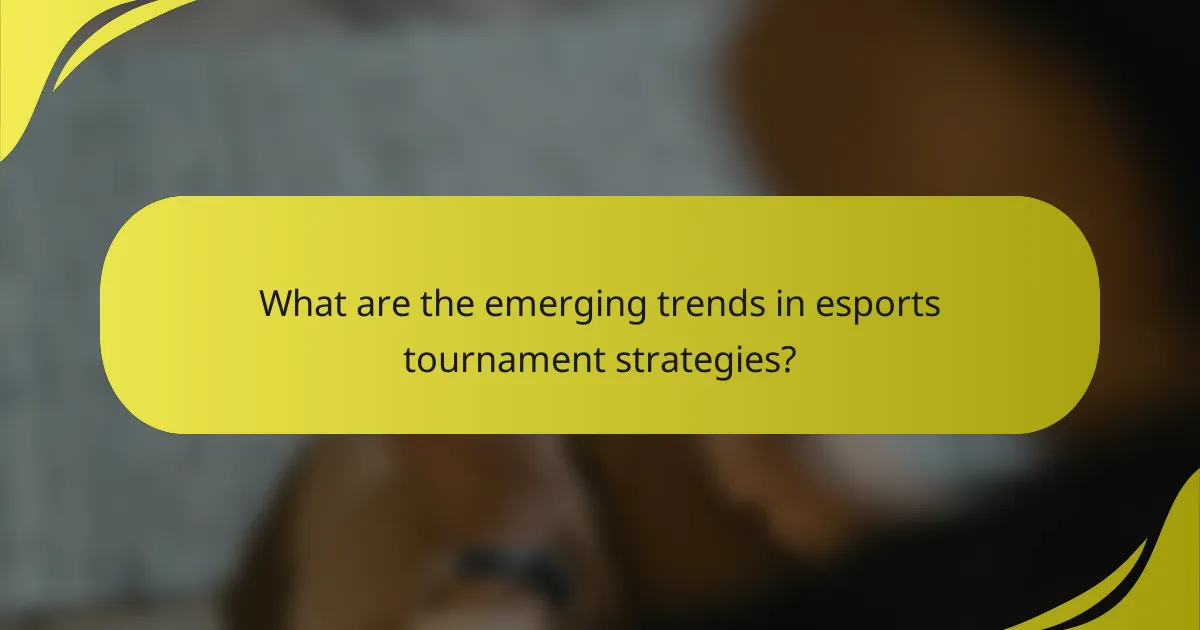
What are the emerging trends in esports tournament strategies?
Emerging trends in esports tournament strategies focus on leveraging technology, adapting gameplay in real-time, and fostering a resilient mindset. Teams are increasingly using data-driven approaches to refine their tactics and improve performance after early setbacks.
Integration of AI in gameplay analysis
The integration of AI in gameplay analysis is revolutionizing how teams prepare for tournaments. AI tools can analyze vast amounts of gameplay data to identify patterns, strengths, and weaknesses, allowing teams to make informed strategic adjustments. This technology can provide insights into opponent behaviors and suggest counter-strategies.
For example, AI can track player movements and decision-making processes, helping teams understand where they can improve their own gameplay. By utilizing AI-driven analytics, teams can refine their strategies based on real-time data, enhancing their chances of success in high-pressure situations.
To effectively integrate AI, teams should focus on selecting the right tools that align with their specific needs. It’s important to regularly update the data inputs and ensure that all team members understand how to interpret AI-generated insights. Avoid over-reliance on technology; human intuition and experience remain crucial in decision-making during tournaments.
